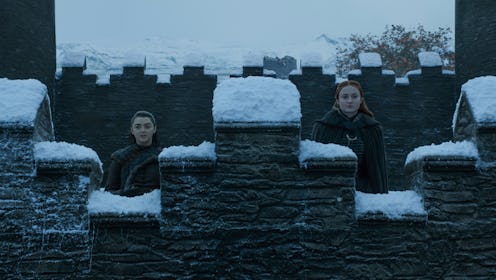Entertainment
How 'Game of Thrones' Suddenly Made Sisterhood One Of The Most Powerful Forces In Westeros

Over the course of Game Of Thrones, Petyr "Littlefinger" Baelish has pulled off a lot of ridiculously complicated Machiavellian schemes to earn more power in the realm — despite looking like the most untrustworthy person alive. He managed to poison Jon Arryn, pin it on the Lannisters, and betrayed Ned Stark just in the show’s first season, and all without being detected. But in the Season 7 finale, he finally met his match when he tried to turn Sansa and Arya Stark against one another so he could continue to hold on to power in Winterfell. Ultimately, Sansa and Arya’s sisterhood proved too strong on Game of Thrones, which speaks to how the show might be finally changing for the better.
Of course, for most of this season’s second half, it seemed as though Littlefinger's plan to turn the sisters against each other might actually be working. After Arya discovered the letter Sansa was forced to write to Robb way back in Season 1, her confrontation with her sister truly did seem rooted in the longtime rivalry the two shared before arriving at King’s Landing. Still, it seemed a little off considering what the two girls have been through since then — and how they’ve both seen Littlefinger’s scheming nature firsthand.
In fact, the way they seemed to play right into Littlefinger’s hands had many fans and critics upset with the two Stark sisters. Uproxx called it “this season’s most confusing Game Of Thrones relationship”; The Ringer suggested it was a problem that needed solving, saying, “Arya refusing to believe that someone whom she personally saw scream in agony upon their father’s beheading didn’t actually mourn him beggared belief." Some chalked it up to bad writing on the part of showrunners David Benioff and D.B. Weiss; still others theorized that they were secretly teaming up to take down Littlefinger — why else would they appear to be making such careless mistakes?
The latter ended up being right. As the storyline continued into the Season 7 finale, it seemed more and more obvious that something was up, especially during the scene when Sansa sat there offering up conclusions about Arya’s possible betrayal while Littlefinger nodded proudly; after all, Sansa knows him well and wouldn’t be quite so thirsty for his approval otherwise. Still, that didn’t make the moment where the two sisters turned on him in the Great Hall less satisfying, in no small part because of how they framed themselves as sisters that he could not divide.
As Sansa points out, Baelish also set their jealous Aunt Lysa against their mother, Catelyn, which ultimately lead to both their deaths and the deaths of their husbands — and to the deaths of almost everyone else on the entire show, when you think about it. And thanks to Bran’s warging powers as the Three-Eyed Raven, Sansa now knows everything that Petyr’s done, and knows how to play into his expectations. “That’s what you’ve always done, turned family against family, turned sister against sister. That’s what you did to our mother and Aunt Lysa, that’s what you tried to do to us,” Sansa says to Baelish, adding, “I’m a slow learner, it’s true. But I learn.”
Much of Game Of Thrones is centered around the way that the previous generation’s mistakes affect their offspring, and how that younger generation watches and learns from those errors. If Robert’s Rebellion had not gone down the way it had, for example, Petryr Baelish wouldn’t have been able to manipulate the remaining Westeros families as easily as he did to bring about the War of Five Kings. Sansa and Arya cannot undo all that damage done by their predecessors by killing him, but as they demonstrated in “The Dragon And The Wolf,” they can choose not to repeat the fates of the last two sisters Baelish ensnared.
There’s also the added bonus that Sansa and Arya exist in a world that systematically devalues young women and that had already succeeded in pitting them against each other even before now, based on how well the two were able to perform their assigned gender roles growing up. That the two were able to overcome all of that to bring down a lord who, by all accounts, had more power and standing than them is an incredible feat, and speaks to the untapped power that female friendship and camaraderie has even in Westeros, where femininity is all but synonymous with inferiority.
Now, Baelish won’t be around anymore to flit about in the shadows and cause havoc; Arya made sure of that when she slit his throat (and in a similar manner to the way Catelyn’s was slit during the Red Wedding, which can’t be a coincidence). But the real victory wasn’t in stopping him; it was in proving Ned Stark’s famous words: “the lone wolf dies, but the pack survives.” Seeing both him and Catelyn die split apart from their families has taught Sansa and Arya a valuable lesson, and as Game Of Thrones prepares for its final season in the next few years, it will be interesting to see how they continue to strengthen those bonds — and if doing so can ensure their survival when the winds of winter come.